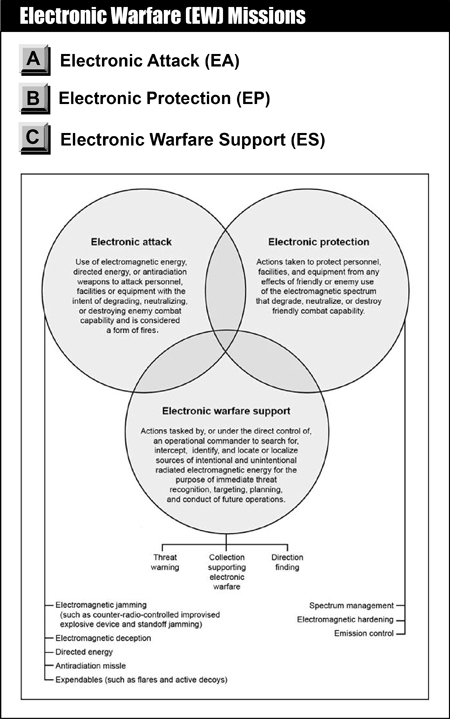Electronic warfare refers to military action involving the use of electromagnetic and directed energy to control the electromagnetic spectrum or to attack the enemy (JP 3-13.1). EW capabilities enable Army forces to create conditions and effects in the EMS to support the commander’s intent and concept of operations.
A. Electronic Attack (EA)
EA involves the use of electromagnetic energy, directed energy, or anti-radiation weapons to attack personnel, facilities, or equipment with the intent of degrading, neutralizing, or destroying enemy combat capability and is considered a form of fires. EA includes—
• Actions taken to prevent or reduce an enemy’s effective use of the EMS.
• Employment of weapons that use either electromagnetic or directed energy as their primary destructive mechanism.
• Offensive and defensive activities, including countermeasures.
EA includes using weapons that primarily use electromagnetic or directed energy for destruction. These can include lasers, radio frequency weapons, and particle beams. Directed energy is an umbrella term covering technologies that relate to the production of a beam of concentrated electromagnetic energy or atomic or subatomic particles (JP 3-13.1). In EW, most directed-energy applications fit into the category of EA. A directed-energy weapon uses electromagnetic energy to damage or destroy an enemy’s equipment, facilities, and/or personnel. In addition to destructive effects, directed-energy weapon systems support area denial and crowd control.
B. Electronic Protection (EP)
EP involves actions taken to protect personnel, facilities, and equipment from any effects of friendly or enemy use of the EMS that degrade, neutralize, or destroy friendly combat capability. For example, EP includes actions taken to ensure friendly use of the EMS, such as frequency agility in a radio or variable pulse repetition frequency in radar. Commanders should avoid confusing EP with self-protection. Both defensive EA and EP protect personnel, facilities, capabilities, and equipment. However, EP protects from the effects of EA (friendly and enemy) and electromagnetic interference, while defensive EA primarily protects against lethal attacks by denying enemy use of the EMS to guide or trigger weapons.
During operations, EP includes, but is not limited to, the application of training and procedures for countering enemy EA. Army commanders and forces understand the threat and vulnerability of friendly electronic equipment to enemy EA and take appropriate actions to safeguard friendly combat capability from an exploitation and attack. EP measures minimize the enemy’s ability to conduct ES and EA operations successfully against friendly forces. To protect friendly combat capabilities, units—
• Regularly brief friendly force personnel on the EW threat.
• Safeguard electronic systems during exercises and pre-deployment training.
• Coordinate and deconflict EMS usage.
• Limit the EMS signatures to reduce adversary ability to locate nodes.
• Provide training during routine home station planning and training activities on appropriate EP active and passive measures under normal conditions, conditions of threat EA, or otherwise degraded networks and systems.
• Take appropriate actions to minimize the vulnerability of friendly receivers to enemy jamming (such as reduced power, brevity of transmissions, and directional antennas).
• Ensure redundancy in systems is maintained and personnel are well-versed in switching between systems.
C. Electronic Warfare Support (ES)
ES involves actions tasked by, or under direct control of, an operational commander to search for, intercept, identify, and locate or localize sources of intentional and unintentional radiated electromagnetic energy for the purpose of immediate threat recognition, targeting, planning, and conduct of future operations ES enables U.S. forces to identify the electromagnetic vulnerability of an enemy’s or adversary’s electronic equipment and systems. Friendly forces take advantage of these vulnerabilities through EW operations.
ES systems are a source of information for immediate decisions involving EA, EP, avoidance, targeting, and other tactical employment of forces. ES systems collect data and produce information to—
• Corroborate other sources of information or intelligence
• Conduct or direct EA operations
• Create or update EW databases
• Initiate self-protection measures
• Support EP efforts
• Support information related capabilities
• Target enemy or adversary systems
 This article is an extract from “CYBER1: The Cyberspace Operations & Electronic Warfare SMARTbook (Multi-Domain Guide to Offensive/Defensive CEMA and CO)” by The Lightning Press. Download a free PDF sample and learn more at: CYBER1: The Cyberspace Operations & Electronic Warfare SMARTbook.
This article is an extract from “CYBER1: The Cyberspace Operations & Electronic Warfare SMARTbook (Multi-Domain Guide to Offensive/Defensive CEMA and CO)” by The Lightning Press. Download a free PDF sample and learn more at: CYBER1: The Cyberspace Operations & Electronic Warfare SMARTbook.
Browse additional military doctrine articles in our SMARTnews Blog & Resource Center.
About The Lightning Press SMARTbooks. Recognized as a “whole of government” doctrinal reference standard by military, national security and government professionals around the world, SMARTbooks comprise a comprehensive professional library. SMARTbooks can be used as quick reference guides during operations, as study guides at education and professional development courses, and as lesson plans and checklists in support of training. Browse our collection of Military Reference SMARTbooks to learn more.














































